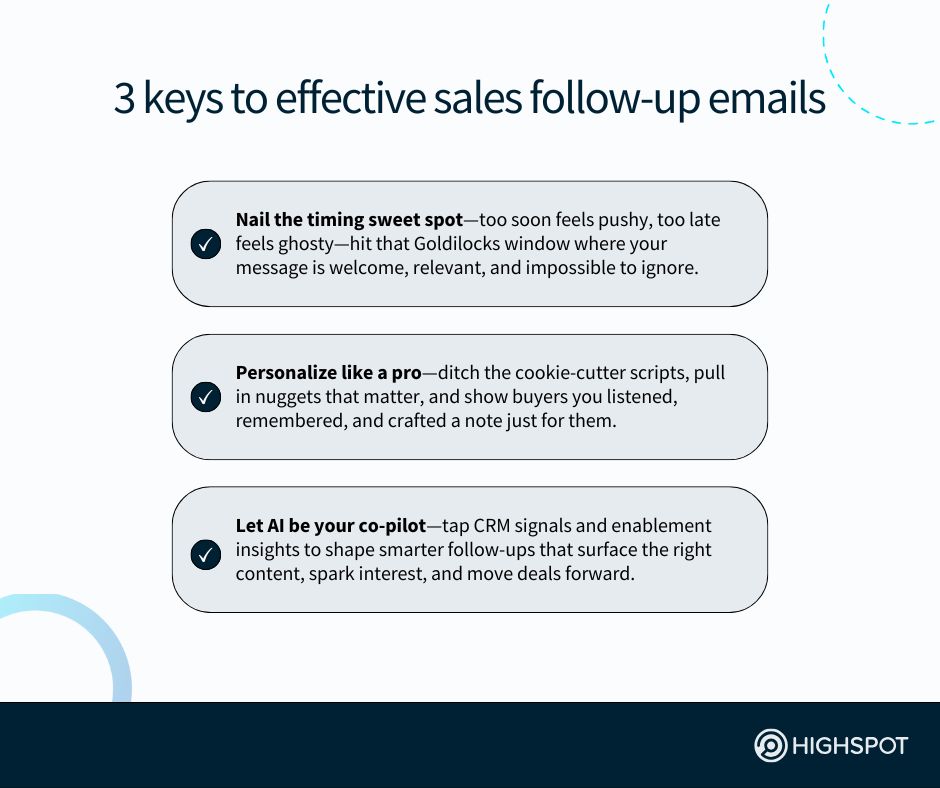Key Takeaways
- A sales follow-up email is that friendly nudge in the inbox, keeping conversations warm, deals alive, and prospects reminded you’re still here, ready to make business happen.
- Timely, personalized follow-up messages show buyers you care, boost response odds, and turn one-off chats into real relationships that inch closer to revenue with every thoughtful touchpoint.
- With an AI-powered sales enablement platform, reps fine-tune follow-ups, use data-driven insights, and craft messages that land smarter, faster, and sharper than any guesswork could.
You just sent what you thought was a perfect sales email. It was polished, contained a personal note, and timed just right. And then, days pass with silence.
No reply. No read receipt. Just the familiar frustration of being ignored.
But silence isn’t always rejection. It may just mean your prospect is busy and needs the right nudge. That’s where a timely sales follow-up email comes in.
Delivering the right message at the right moment—something you can accomplish with the aid of your sales enablement team and software—is your best bet to restart the conversation and keep your business top of mind with ‘hot’ leads.
If you need sales follow-up email examples and insights to elevate your buyer engagement efforts—from learning the ideal email subject lines to use, to leveraging trigger events to auto-send well-timed messages—this guide is for you.

What is a sales follow-up email?
A sales follow-up email is a message sent to a previously engaged lead after an initial interaction to keep a conversation moving toward closed-won. It helps you stay top of mind and build trust with buyers and keep deals from going cold.
Often used to gently remind a prospect about a previous message, meeting, or offer, it’s a crucial lever for boosting response rates, moving active opportunities forward in your sales pipeline, and steadily advancing your deals to the finish line.
Think of it as a second handshake—digital, but just as vital. The email subject line? That’s your first impression, so you must make it enticing and irresistible.
A good sales follow-up email can reengage even the flakiest target customer and loop in with other stakeholders at the prospect’s company. In a world of inbox overload, it’s your secret weapon to cut through the noise and keep momentum alive.
Benefits of a follow-up sales email
No deals close after a single email. Prospects are often just too busy, distracted, or cautious, which is why silence is so common. A timely follow-up can turn the silence into a conversation. In fact, first follow-ups are known to boost reply rate by 49%.
Follow-ups work because they capture attention again. Here’s the problem, though. Buyers can take their time. You have quotas and deadlines. That is why you need purposeful, personalized follow-ups that match where your buyer is in the sales cycle.
5 steps to writing a sales follow-up email that reengages buyers
Crafting the perfect follow up sequence requires you to write clearly, time the send, and know your audience. Whether it’s your first follow up or your final attempt, these five steps give you a simple path to follow. Messages will be memorable, relevant, and persuasive.
1. Use an attention-grabbing subject line
Your subject line is often the first (and sometimes the only) thing your prospect sees. If it doesn’t catch their eye, the rest of your email will never be read. Keep it short and remove the jargon. Remember: Great subject lines are:
- Under eight words or 40 characters
- Relevant to their situation
- Timely, useful, or personal
Try, “Quick chat about [project goals]” or “Following up on our call earlier today.”
Try A/B testing with teammates to see what works best. Gartner suggests you, “write the subject line last, after you’ve had a chance to digest the content in the body of the email.”
2. Personalize your greeting and introduction
Generic intros immediately feel like spam. A personal one shows you remember the person and that you care about the relationship. You’re not just sending a standard template.
Easy ways to personalize include:
- Mention a recent meeting, demo, or previous email
- Refer to a networking event or shared contact
- Call out something about their role, project, or their company
For example, “Hi Sam—congrats on last week’s product launch. That was a big milestone for the team. I’d love to hear how it went.” This line shows that you are paying attention. It feels very natural. It will set you apart from the mass of copy-paste templates
3. State the reason for your follow-up
Don’t dance around your point. Imagine your reader is checking their messages at a stoplight. They should know why you wrote by the second line. Brevity wins here.
For example:
- “I wanted to follow up on the proposal I sent over last Thursday.”
- “Just looping back on our last conversation around your onboarding challenges.”
- “Checking in to see if you’re still exploring a solution for [pain point].”
Your clarity makes the email matter. Plus, your availability is often your advantage. The sales reps who answer quickly, suggest a quick call, or clear up any lingering questions that leads may have are the ones who move deals forward fastest.
4. Add value
A follow-up should never be just “checking in.” Every message is a chance to add value.
That might look like:
- Sharing an industry stat or insight
- Answering a question from your first conversation
- Sending a customer case study or win that aligns with their pain point
For example, “Here’s a case study where a company similar to yours cut onboarding time by 30% using the workflow we discussed.”
If a prospect goes quiet after a demo, they may still be reviewing or waiting on a manager. In that case, you could say: “I know your team is deep in planning this week. I wanted to send over this one-pager that recaps how our solution cuts onboarding time. Let me know if you would like to walk through it next week.”
This is where a best-in-class sales enablement tool can help. Highspot’s Gmail and Outlook integration lets you add collateral or a Digital Sales Room straight into the thread.
What’s more, AutoDocs can create personalized decks for reps that stand out.
The big question to ask yourself before hitting send is, “What’s one useful, interesting, or relevant thing I share here that proves I understand their needs?”
5. Propose a next step with a clear CTA
The best follow-up emails to recently engaged opportunities in your pipeline end with one clear, low-pressure next step. If your call to action is vague, nothing happens.
Avoid “Let me know what you think.” It’s just too generic, and it simply doesn’t inspire leads to take urgent action or set a reminder to check back with you in a few days or weeks.
Instead, try something like:
- “Are you open to a 15-minute call this week?”
- “Is Thursday at 2:00 p.m. your time good for you?”
- “Should I loop in someone from your team to answer technical questions?”
Sometimes prospects go cold simply because they’re buried in their day job. A clear but gentle call to action gives them an easy way to respond.
If you have sent multiple follow ups with no reply, do not panic. It does not mean you lost the deal. Mark the prospect as “cold” in your CRM, but set a reminder to check back in a few weeks or months. Timing can make all the difference.
The patient sales rep who reappears later can be the one who finally gets that reply.
8 sales follow-up email templates
A follow-up email may feel harder than the initial email itself.
These follow-up email templates will feel real, not robotic. Each one fits a common sales scenario and shows how to write a follow up with a personal touch, clear call to action, and the right level of persistence to keep the sales process moving along.
Remember: These examples are just a framework to help you craft more compelling messages and avoid common follow-up mistakes so you can develop a repeatable, scalable cadence for checking back in with and ‘waking up’ leads.
1. After the initial meeting
- When to use: Right after a discovery call, intro chat, or demo
- Why it works: Reinforces key points from the initial call and keeps the ball rolling
- Best practice: Send this follow up email within 24 hours, while the discussion is still fresh in your prospect’s mind.
Sales follow-up email template
Subject: Great talking today
Hi [Name],
I really appreciated our chat about [specific challenge/project]. It’s clear that [Company Name] is focused on [goal discussed], and I’d love to support that.
As promised, here’s [proposal/resource] for review. Would you be open to a quick call later this week to talk next steps?
Looking forward to hearing your thoughts,
[Your Name]
2. Clarifying pricing or proposal details
- When to use: After sharing pricing tied to outcomes
- Why it works: Builds trust by clarifying how cost aligns with results
- Best practice: Highlight how your product or service ties cost to outcomes to reassure decision-makers and keeps your proposal heading in the right direction.
Sales follow-up email template
Subject line example: Following up on pricing details
Hi [Name],
Thanks again for reviewing the proposal. Since our pricing is based on [specific ROI/outcome], I wanted to make sure everything was clear.
If helpful, I can send a short case study showing how another company achieved results with a similar approach.
Would a 15-minute call tomorrow work to walk through the details?
Best,
[Your Name]
3. Following a trigger event
- When to use: After a prospect downloads content, attends a webinar, or clicks on your initial email
- Why it works: Ties your message directly to their recent action
- Best practice: Reference the trigger event directly in the subject line to add a small personal touch that can dramatically improve response rates.
Sales follow-up email template
Subject line example: Saw your interest in [resource]
Hi [Name],
I noticed you checked out [content piece]. Many teams use that guide when addressing [pain point].
Happy to share a few ideas tailored to [Company Name]’s goals—or just answer any questions. Would a short call this week be useful?
Best,
[Your Name]
4. When they need to loop in colleagues
- When to use: When your prospect says they need team input
- Why it works: Keeps the conversation active without adding pressure
- Best practice: Offer a concise summary so you can save buyers them time and position your company as the ‘easy-to-work-with’ vendor.
Sales follow-up email template
Subject line example: Support for your team discussion
Hi [Name],
Hope your internal review went smoothly. If helpful, I can prepare a short one-pager for your colleagues that outlines the key points we discussed.
Would you like me to send that, or should we set a quick chat to align before your next meeting?
Cheers,
[Your Name]
5. After a networking event
- When to use: After meeting at a trade show or casual event
- Why it works: Brings back your personal touch while the memory is fresh
- Best practice: Always mention a detail from the last conversation to separate you from the dozens of other email follow ups they’ll receive.
Sales follow-up email template
Subject line example: Great to meet at [Event Name]
Hi [Name],
It was great connecting at [event], especially our conversation about [topic]. I’d love to continue that discussion and hear more about how [Company Name] is approaching [pain point].
Would you be open to a short call next week to explore it further?
Looking forward to staying in touch,
[Your Name]
6. Wrong person (ask for the right person)
- When to use: If you realize you’ve contacted the wrong person.
- Why it works: Respectful, and often earns a redirect to the right person.
- Best practice: Keep this one very short and to-the-point. Over-explaining feels defensive, and your goal is to be redirected quickly to the right person.
Sales follow-up email template
Subject line example: Did I reach the right person?
Hi [Name],
I wanted to make sure I reached out to the right person regarding [topic]. If not, no problem—I’d appreciate it if you could point me in the right direction.
Thanks for your help,
[Your Name]
7. Offering a demo, trial, or sample
- When to use: When you want them to try your product or service firsthand
- Why it works: Moves the conversation from theory to experience
- Best practice: Pairing the best subject line with a hands-on offer creates urgency and reduces hesitation about testing your solution.
Sales follow-up email template
Subject line example: Here’s your access link
Hi [Name],
As promised, here’s your [demo/free trial/sample]. I suggest starting with [specific feature or use case]—that’s where most teams see immediate value.
I’d be glad to walk you through it live if that’s helpful. Would [day/time] work?
Best,
[Your Name]
8. Last attempt before closing the file
- When to use: After multiple follow ups with no reply
- Why it works: Professional, respectful, and leaves the door open
- Best practice: Use this sparingly. Ending your follow up sequence gracefully avoids burning bridges, and often prompts a final response when nothing else has worked.
Sales follow-up email template
Subject line example: Should I close your file?
Hi [Name],
I haven’t heard back, so I’ll assume the timing isn’t right. Totally understandable.
I’ll close the loop for now, but if priorities shift—or if revisiting this makes sense—I’m always just a reply away.
Wishing you success,
[Your Name]
Sales follow-up email best practices
Now that you have the sales follow-up email sequence down, you need to make every follow-up message work for your audience. Here are some proven best practices that keep your sales email follow-ups clear, human, and compelling:
- Be clear about your product or service: Say what it does, who it is for, and the outcome they’ll experience. Keep it simple. Example: “Our tool helps small IT teams cut onboarding time in half.”
- Keep it human and down to earth: Write like you talk. A slight personal touch from something you’ve learned about them, like “I hope your event went smoothly,” goes further than a perfectly polished pitch.
- Leverage your data and insights: Drop in a stat or quick case study to back you up. Example: “One customer cut costs by 20% using this workflow.”
- Use sales automation with care: An AI-powered enablement platform can send reminders, but always edit your follow-up email template before you hit send. It shows you paid attention during your previous conversation.
- Plan your timing: Send your first follow-up email right after initial contact. Then, avoid annoying the prospect and space out later touches over a few weeks.
Over time, you can test approaches, adjust as needed, and find your own rhythm. Before long, writing a follow-up will feel as natural as sending a message to a friend.
Remember: Your next closed deal could just be one sales follow-up email away
It’s not always about the most perfect timing or some clever tricks, when it comes to sending successful sales follow-ups. Sometimes, it’s just luck.
That said, clear, intentional, and persistent communication is how you learn what works (gets leads to open and take action from your email), what doesn’t, and how you can replicate winning sales behaviors that help advance leads in the funnel.
Test different ways of writing your email subject line. Change up your tone. Share sales collateral that is specific to your account and decision-makers distinct needs. Use email follow-up templates, but tweak them for personalization.
But, most importantly, just be ‘you’ in every single message.




